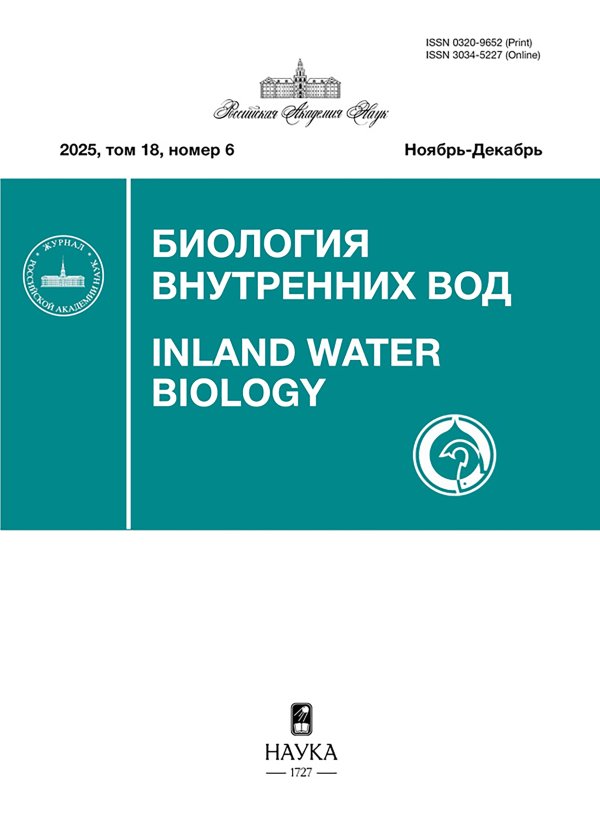Organisation of Fish Assemblage in the Mekong Delta as a Potential Indicator of Salt Water Intrusion
- Authors: Malin M.1,2, Malina I.1, Hai T.3, Dinh C.3, Man L.3, Chi D.3
-
Affiliations:
- Papanin Institute for Biology of Inland Waters, Russian Academy of Sciences
- Severtsov Institute of Ecology and Evolution, Russian Academy of Sciences
- Southern Branch of the Joint Russia-Vietnam Tropical Science and Technology Research Center
- Issue: No 2 (2023)
- Pages: 252-263
- Section: ИХТИОЛОГИЯ
- URL: https://journals.rcsi.science/0320-9652/article/view/134955
- DOI: https://doi.org/10.31857/S0320965223020171
- EDN: https://elibrary.ru/BTSRNT
- ID: 134955
Cite item
Full Text
Abstract
The problem of salt water intrusion into the Mekong Delta is a research topic involving various branches of science. Among the causes of this phenomenon are global sea level rise and regulation of the natural river discharge due to hydropower dam construction. The scale of the delta and its water dynamics complicate instrument-based observations. Meanwhile, communities of living organisms can serve as indicators of environmental heterogeneity. This study aimed to analyze the spatial variability of fish assemblage organisation in the Mekong Delta for use as an indicator of salt water intrusion. The composition of fish assemblages in different parts of the delta were determined by midwater trawl catches during January and April 2021. A total of ~15 thousand individual fish from 74 trawl hauls were captured and analyzed. The null hypothesis was that the fish assemblages in the Mekong Delta are represented by three taxonomic complexes that are localized in the upper course (freshwater), the lower course (brackish) and the middle course (zone of the contact of the fresh and brackish waters) of the delta. The taxonomic composition of the freshwater complex is the most poor and is represented by 9 families. Meanwhile, marginal (the contact zone) and brackish complexes include 26 and 23 families, respectively. Specimens of families Cobitidae, Eleotridae, Plotosidae and Siluridae that are only found in the zone of contact of fresh and brackish waters could be considered as indicator species of its position. The actual boundaries of the brackish and freshwater complexes were determined and the distance from them to the marine delta edge equals 34 and 78 km, respectively. Assessment of the salinity values that correspond to the complex boundaries is a task for future investigation. The position of the boundaries of freshwater and brackish fish taxonomic complexes has a biological basis and could be used as an indicator of salt water intrusion into the Mekong Delta.
About the authors
M. I. Malin
Papanin Institute for Biology of Inland Waters, Russian Academy of Sciences; Severtsov Institute of Ecology and Evolution, Russian Academy of Sciences
Author for correspondence.
Email: mishuk@ibiw.ru
Russia, Nekouzskii raion, Yaroslavl oblast,
Borok; Russia, Moscow
I. P. Malina
Papanin Institute for Biology of Inland Waters, Russian Academy of Sciences
Email: mishuk@ibiw.ru
Russia, Nekouzskii raion, Yaroslavl oblast,
Borok
Truong Ba Hai
Southern Branch of the Joint Russia-Vietnam Tropical Science and Technology Research Center
Email: mishuk@ibiw.ru
Vietnam, Ho Chi Minh City
Cu Nguyen Dinh
Southern Branch of the Joint Russia-Vietnam Tropical Science and Technology Research Center
Email: mishuk@ibiw.ru
Vietnam, Ho Chi Minh City
Le Quang Man
Southern Branch of the Joint Russia-Vietnam Tropical Science and Technology Research Center
Email: mishuk@ibiw.ru
Vietnam, Ho Chi Minh City
Duong Thi Kim Chi
Southern Branch of the Joint Russia-Vietnam Tropical Science and Technology Research Center
Email: mishuk@ibiw.ru
Vietnam, Ho Chi Minh City
References
- Болтачев А.Р., Карпова Е.П., Статкевич С.В. и др. 2018. Особенности количественного распределения рыб и десятиногих ракообразных в дельте реки Меконг в меженный период 2018 г. // Мор. биол. журн. Т. 3. № 4. С. 14. https://doi.org/10.21072/mbj.2018.03.4.02
- Binh D.V., Kantoush S.A., Saber M. et al. 2020. Long-term alterations of flow regimes of the Mekong River and adaptation strategies for the Vietnamese Mekong Delta // J. Hydrology: Regional Studies. V. 32. P. 100 742. https://doi.org/10.1016/j.ejrh.2020.100742
- Chea R., Lek S., Ngor P., Grenouillet G. 2017. Large-scale patterns of fish diversity and assemblage structure in the longest tropical river in Asia // Ecol. Freshwater Fish. V. 26. № 4. P. 575. https://doi.org/10.1111/eff.12301
- Cyrus D.P., Blaber S.J.M. 1992. Turbidity and salinity in a tropical northern Australian estuary and their influence on fish distribution // Estuar. Coast. Shelf Sci. V. 35. № 6. P. 545. https://doi.org/10.1016/S0272-7714(05)80038-1
- Das S.K., Chakrabarty D. 2007. The use of fish community structure as a measure of ecological degradation: A case study in two tropical rivers of India // BioSystems. V. 90. № 1. P. 188. https://doi.org/10.1016/j.biosystems.2006.08.003
- Eslami S., Hoekstra P., Kernkamp H.W.J. et al. 2021. Dynamics of salt intrusion in the Mekong Delta: results of field observations and integrated coastal–inland modelling // Earth Surf. Dynam. V. 9. № 4. P. 953. https://doi.org/10.5194/esurf-9-953-2021
- Huang J., Huang L., Wu Z. et al. 2019. Correlation of fish assemblages with habitat and environmental variables in a headwater stream section of Lijiang River, China // Sustainability. V. 11. № 4. P. 1135. https://doi.org/10.3390/su11041135
- Karpova E.P., Boltachev A.R., Ablyazov E.R. et al. 2021. Spatial variations in fish abundance in the Mekong Delta // Russ. J. Ecol. V. 52. № 2. P. 146. https://doi.org/10.1134/S1067413620050082
- Lasne E., Bergerot B., Lek S., Laffaille P. 2007. Fish zonation and indicator species for the evaluation of the ecological status of rivers: example of the Loire basin (France) // River Res. Appl. V. 23. № 8. P. 877. https://doi.org/10.1002/rra.1030
- Liu F., Wang J., Zhang F.-B. et al. 2020. Spatial organisation of fish assemblages in the Chishui River, the last free-flowing tributary of the upper Yangtze River, China // Ecol. Freshwater Fish. V. 30. № 1. P. 48. https://doi.org/https://doi.org/10.1111/eff.12562
- Miranda R., Rios-Touma B., Falconi-Lopez A. et al. 2022. Evaluating the influence of environmental variables on fish assemblages along Tropical Andes: considerations from ecology to conservation // Hydrobiologia. V. 849. № 20. P. 4569. https://doi.org/10.1007/s10750-021-04726-3
- Nguyen A.D., Savenije H.H.G., Pham D.N., Tang D.T. 2008. Using salt intrusion measurements to determine the freshwater discharge distribution over the branches of a multi-channel estuary: The Mekong Delta case // Estuarine, Coastal Shelf Sci. V. 77. № 3. P. 433. https://doi.org/10.1016/j.ecss.2007.10.010
- Nuon V., Lek S., Ngor P.B. et al. 2020. Fish community responses to human-induced stresses in the Lower Mekong Basin // Water. V. 12. № 12. P. 3522. https://doi.org/10.3390/w12123522
- R: A language and environment for statistical computing. R Foundation for Statistical Computing, Vienna, Austria. URL https://www.R-project.org/.
- Rainboth W.J. 1996. Fishes of the Cambodian Mekong. FAO species identification field guide for fishery purposes. Rome: FAO.
- Sharov A.N., Tsvetkov A.I., Korneva L.G., Dinh C.N. 2020. Phytoplankton of the delta of the Mekong River during the dry season // Biosystems Diversity. V. 28. № 3. P. 329. https://doi.org/10.15421/012041
- Steichen J.L., Quigg A. 2018. Fish species as indicators of freshwater inflow within a subtropical estuary in the Gulf of Mexico // Ecol. Indic. V. 85. Suppl. A. P. 180. https://doi.org/10.1016/j.ecolind.2017.10.018
- Tan L.V., Tran T., Loc H.H. 2020. Soil and water quality indicators of diversified farming systems in a saline region of the Mekong Delta, Vietnam // Agriculture (Basel, Switz.). V. 10. № 2. P. 38. https://doi.org/10.3390/agriculture10020038
- Thang N.C., Ngoc H.H., Tuet T.T. 2020. Climate change adaptation policies of Vietnam in the Mekong Delta // Russ. J. Vietnam Stud. Series 2. № 3. P. 36. https://doi.org/10.24411/2618-9453-2020-10023
- Tri D.Q., Don N.C., Ching C.Y., Mishura P.K. 2014. Modeling the influence of river flow and salinity intrusion in the Mekong River Estuary, Vietnam // Lowland Technol. Int. V. 16. № 1. P. 14. https://doi.org/10.14247/lti.16.1_14
- Tran D.D., Shibukawa K., Nguyen P.T. et al. 2013. Fishes of the Mekong Delta, Vietnam. Can Tho: Can Tho University Publishing House.
- Tuan L.A., Chinvanno S. 2011. Climate change in the Mekong River Delta and key concerns on future climate threats // Environmental Change and Agricultural Sustainability in the Mekong Delta. Dordrecht: Springer. P. 207. https://doi.org/10.1007/978-94-007-0934-8_12
- Valbo-Jorgensen J., Coates D., Hortle K. 2009. Chapter 8 – Fish diversity in the Mekong River basin // The Mekong: Biophysical environment of an International river basin. Amsterdam: Elsevier Publishers. P. 161. https://doi.org/10.1016/B978-0-12-374026-7.00008-5
- Whitfield A.K., Elliott M. 2002. Fishes as indicators of environmental and ecological changes within estuaries: a review of progress and some suggestions for the future // J. Fish Biol. V. 61. P. 229. https://doi.org/10.1111/j.1095-8649.2002.tb01773.x
- Wu J., Wang J., He Y., Cao W. 2011. Fish assemblage structure in the Chishui River, a protected tributary of the Yangtze River // Knowl. Manag. Aquat. Ecosyst. V. 400. № 11. https://doi.org/10.1051/kmae/2011023
- Yuan D., Chen L., Luan L. et al. 2020. Effect of salinity on the zooplankton community in the Pearl river estuary // J. Ocean Univ. China. V. 19. № 6. P. 1389. https://doi.org/10.1007/s11802-020-4449-6
- Zhang C., Zhu R., Sui X. et al. 2021. Understanding patterns of taxonomic diversity, functional diversity, and ecological drivers of fish fauna in the Mekong River // Global Ecol. Conserv. V. 28. e01711. https://doi.org/10.1016/j.gecco.2021.e01711
Supplementary files














